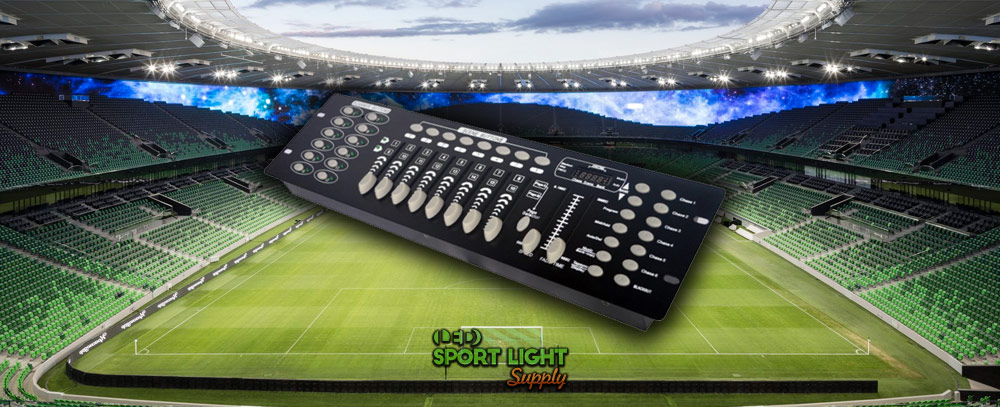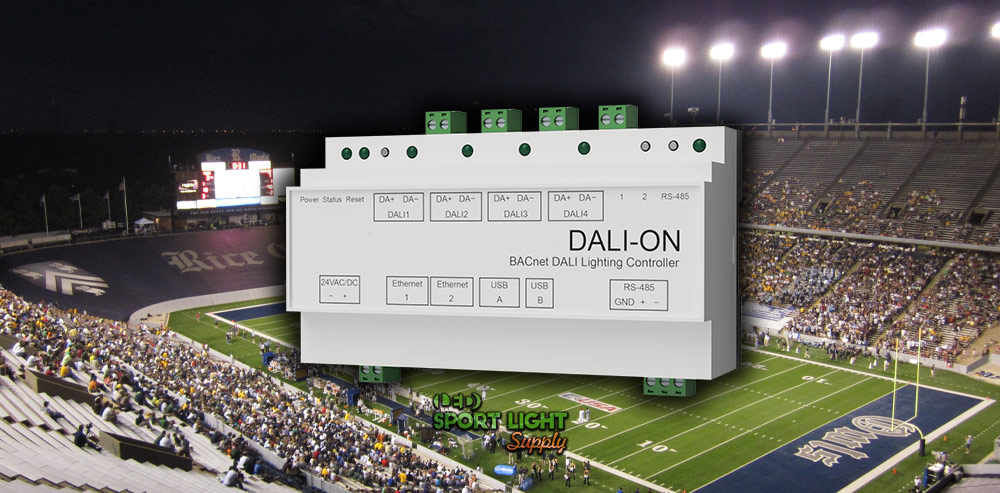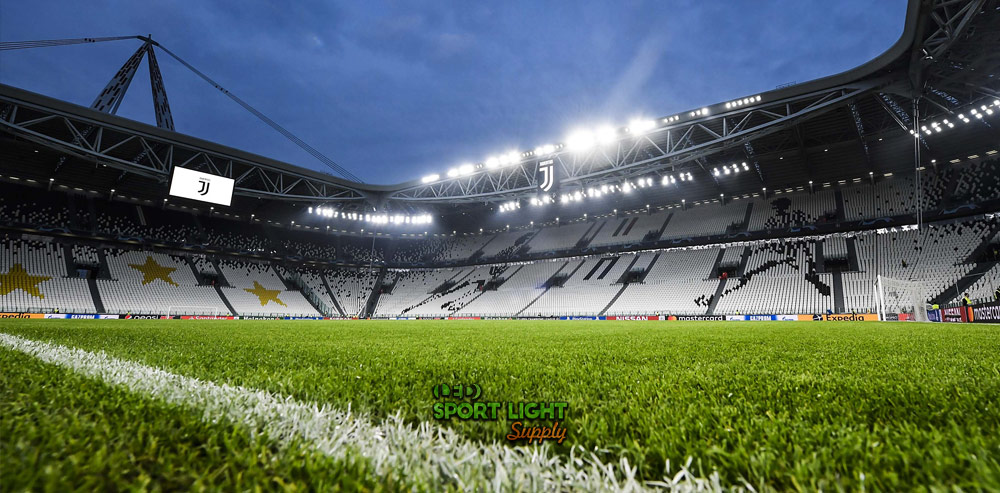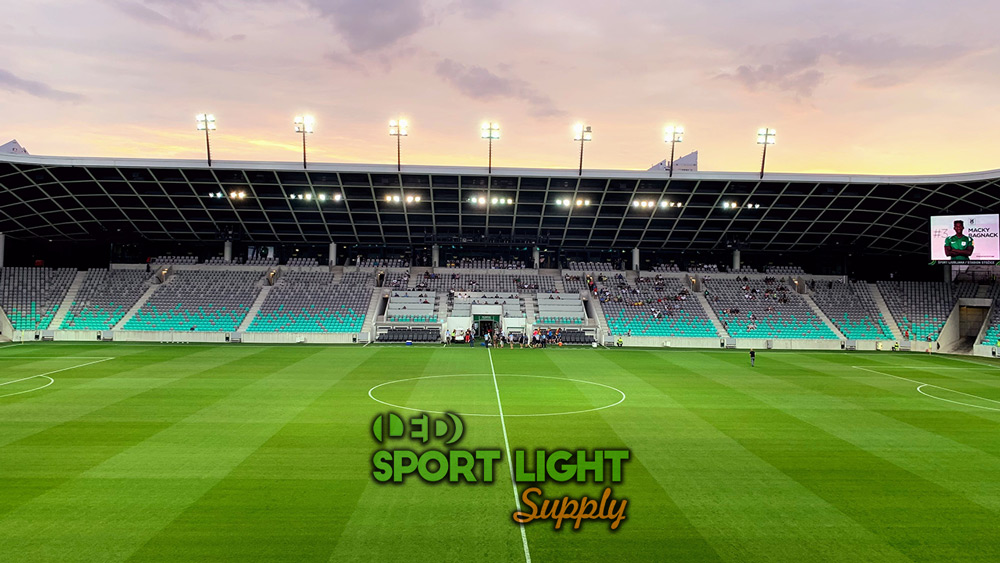Stadium and field lighting that use LED sports lights will need control systems that connect all of the lights used. This is so certain aspects of sports activity can become more professional and add a bit of entertainment value. Sports fans have come to embrace this theatricality, which is why these two types of light controllers are discussed here. The DMX and DALI lighting systems both differ, so you’ll want to know their strengths and weaknesses.
What is DMX?

The DMX lighting system is perhaps better known in the sports world as the Rolls Royce of lighting controllers. It’s essentially a centralized control system that can control up to 512 separate light sources (1 channel per lamp). It will be able to cover a distance through wire connection up to 300 meters. This system requires the use of drop connectors (RS422 or RS485) which allow the control board to control more lights. So, to control 512 light sources, these drop connectors are essential.
One ideal advantage of the DMX controller is that it can control the color of LED lights. But to do this, you’ll need RGB-LED light fixtures. If a floodlight is used that doesn’t have color control, it won’t change color since they don’t compare similarly. This is also a fast control speed, so lighting changes are seen instantly as you bring-up or fade the lights accordingly. This is accomplished through digital multiplexing capabilities.
Also, the DMX board is excellent for controlling high mast poles, but not limited to controlling other stadium lights. Because a large number of lights can be controlled, spectator lights are ideal for programming selected light sequencing. These controls can be preprogrammed to do special effects such as light sparkle, sequenced flashing, and other spectator related effects contrast.
What is DALI?

The DALI system is much more simplified but because it’s decentralized, meaning that each lights section can be controlled individually. It also needs to be hardwired between control panels and uses two wires in between each control section. It controls up to 64 LED light fixtures and has a total of 254 brightness levels. The controller itself is a slide switchboard that features on/off buttons for each slide bank.
DALI also runs a total of 300 meters in between connections controlling LED lights but is slower connection speed. This will mean that there is a slight delay when lights are dimmed. Perhaps 1-2 seconds but similar hardwiring will do the same. DALI can control high mast lights but is often preferred for off-field lighting. As expected, it can be mixed to combine field lights and off-field lights as you like.
Because each panel controls a set number of lights, no more than two light fixtures are controlled between single control panels. The fading control is accomplished using a step controller for each fade level. It’s a simplified system that obviously works slower than the DMX. Since DMX uses a CAT-5 cable connection rather than a two-wire system the reaction time is decreased.
Similarities between DMX Vs DALI
1. Light controllers
Anything electrical is going to need a control panel in between each section of light fixtures. For the DALI, these are meant to enable fading control, while the DMX uses a controller that transmits information back to the main controller. These are multifunction control panels that also allow fading and color control. The DMX has a specific type of interface controls that include the RS422 or RS485 controllers.
2. Distance of operations
While DMX and DALI are using different kinds of wiring, the distance they operate remains the same. Both allow up to 300 meters for the lights to be connected to the main controller. This will require that the main control board is placed ideally, allowing no more than 300 meters in any direction. This includes where high mast lights are connected to their fixtures. Even modern super domes are roughly 210 in diameter making it possible to reach all the sections where lighting is located.
3. High mast lights
Both of these controllers will control lights that are placed on high mast poles. Despite the wiring differences that relate back to operating speed. High mast lights for the DALI system will require 2 light fixtures per control unit. The DMX will need a separate interface controller for each light bank.
4. Off-field lights
These are the lights that are connected to spectator lights and any areas that are stadium-related. These can include fading control that’s reduced to levels where spectators can still navigate stairs and walkways. It can also highlight a big win by raising the house lights on selected team goals or scores.
Difference between DMX Vs DALI
1. Color control
Only the DMX offers the option to handle color control. This also requires that a specialized LED lamp used for color changing ability is used. The RGB-LED is best for this purpose and isn’t always ideal for field lighting. Not that these lamps can’t be pointed at both the spectators and the field. The DALI control system cannot support changing lights since it’s was designed to be a fader only.
2. Speed control
There is a big contrast difference in speed when using the DMX controller. This has a fast speed interface that gets real-time info from the fixture itself. Because of the type of wiring used, this info is sent back faster allowing on-the-fly lighting control. The DALI is using a two-wire system that has a slight delay of up to 2 seconds. Dimming control isn’t hindered from a slower delay time but does take a moment to compare the results otherwise.
3. Dimming
The dimming control for the DALI is straight forward and has a single slide control and on/off switch button. The DMX has similar options for delays, FX, and preprogrammed time fades. The big difference is that DALI has a warning indicator when light(s) has failed. The DMX is missing this feature. In many ways, the DALI controller is easier to use for simple dimming control, while the DMX does require some training.
4. Controller
The DALI controller looks exactly as you would expect a slide controller to look. It’s a black box controller with slide controls and has an on/off button. The DMX controller panel is a bit more than that with slide controls and preset buttons. It also has lighting control to change and adjust colors. Once again, the two main controllers look nothing alike. The DMX has built-in presets that create different light patterns and FX.
5. Number of lights
This is no doubt the biggest defeat between these two lighting systems. DMX can control up to 512 individual lights (1 channel per light) and fixtures while DALI can control 64 in all. However, there is a perfectly good reason for this. The DMX lighting system is meant to control color lights which can be used for decorative effects. It’s more common now to thrill an audience using changing lights at sports events. Yet DALI is best suited for field and off-field lights usage.
6. Warning indicator lights
DALI has a smart design that gives an immediate warning light when a light bank is not responding. Either the light itself is not functioning or not responding. It could be an indication that the light controller has gone-bad for dimming the LED light. It’s a nice built-in feature that hopefully doesn’t happen. The DMX system is designed so that the interface system receives updates in real-time whether or not lights are responding.
7. Wiring differences
The DMX uses a special interface wire called a CAT-5 cable. This sends and receives information to and from the LED fixture. It also ensures that this information that controls light is direct and fast. Lighting can be adjusted at the same time as the control panel switches are used. While the DALI is using a 2-wire connection set-up, the time difference is longer to reach the main controller.
8. Effect control
The clear winner for making impressive effects comes from the DMX controller. It has more preset effects that can turn any game into a LED light spectacular. This can be combined with color-changing LEDs which add great options for creating a high energy game. It can also be combined with music to heighten certain moments of a sporting match. It’s a great lighting controller for making a game feel so much bigger.

Why DMX or DALI is more popular for stadium lighting?
These light controllers were common in theater stage lighting control. They found a home at stadiums because of the ability to increase or fade sports lighting. The DMX controller is more multi-functional since it remains a simple tool for lighting. Having the added option to use color during an outdoor arena game is a plus. With today’s spectator audience, they like the added effects with lighting.
It’s seen in so many other public displays, why wouldn’t sport stadiums be any different? And because it provides added entertainment value, fans are readily interested in returning to experience a bonus light show. Just as fireworks made certain baseball games more festive, Stadium lighting makes football and cricket match’s more fan-based. For outdoor matches such as tennis, the lighting can be dramatic yet festive. These can potentially celebrate the colors of a competing country or just a selected holiday celebration.
DMX Vs DALI: Which is better for sports fields?
Depending on the sport being played, either one of the lighting systems is capable of controlling the sports lights. The DMX has a slightly fast advantage for speed, while the DALI is just as effective. If the color is going to be used for lighting effects, the DMX offers the best choice for this application. It also has more preset effects to make lights exciting for spectators.
It goes without saying that the DALI system (in contrast) is easy to use and doesn’t require much training to operate. There is a learning curve to the DMX system, but not more than the average DJ would experience. Larger fields and stadiums will find that DMX has more capabilities for light control than the DALI. But with a DALI set-up, smaller venues are satisfying and straight forward.
Since these two are slightly similar if you compare them side by side, the DMX is best for both small and large venues. When field light and color are important, options for combining entertainment and lighting control are solved as an all-in-one package.
Things to consider when selecting a DALI or DMX light system
1. Installation lead time
Either system will require an electrician who knows how to install these systems. Where the wiring goes must be within the limits of 300 meters from the main controller. This includes adding the fader control that allows your LED light to fade correctly. If the DMX system is chosen, then the CAT-5 wiring interface needs special wiring connectors for the cable splices. It will take some time to connect all the lights together so they can work properly.
Each of these companies can also provide tech support for the necessary components that make them work properly.
2. Type of color-changing lights
Only the DMX system allows color-changing LED lights, but your stadium will need to determine which RGB-LED light to use. These can include floodlights, spotlights, or a combination of both. Thankfully the DMX system has up to 170 fixtures (3 channels per RGB lamp) that can be connected giving you plenty of room for expansion. These lights are designed to mix three colors that produce any color shade that you like.
They cannot control light temperature (Kelvin) since this is a special feature of sports lights that is specific unto itself.
3. The amount of wiring involved
A good stadium electrician will know that wiring is often double the amount that’s actually needed. When wiring is started, each light will need to be tested for the right electrical connection. This is where most of the lead time will be spent more than anything else. Since the DALI system uses two wires to connect to each fixture location, this will also take time to install.
4. The cost of adding more lights
Sports lighting is an investment that is followed by a long-term plan for recovering the amount that’s spent. With LED lighting, the return can be satisfying over a long period. If more than 20 years that LED lighting is estimated to work without failure, outgoing costs can be considered high. However, the lifespan of a sports stadium is a higher cost just to build. With as much as 75-85% return savings on LED sports lights, it’s 100% cost-effective already.





